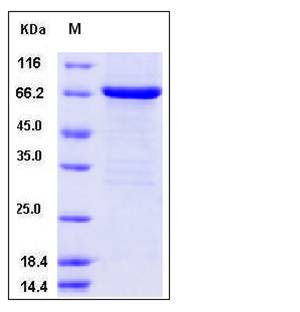Human FGFR2 / CD332 Protein (aa 400-821, His & GST Tag)
BBDS,BEK,BFR-1,CD332,CEK3,CFD1,ECT1,JWS,K-SAM,KGFR,TK14,TK25
- 100ug (NPP3862) Please inquiry
| Catalog Number | P10824-H20B1 |
|---|---|
| Organism Species | Human |
| Host | Baculovirus-Insect Cells |
| Synonyms | BBDS,BEK,BFR-1,CD332,CEK3,CFD1,ECT1,JWS,K-SAM,KGFR,TK14,TK25 |
| Molecular Weight | The recombinant human FGFR2 (aa 400-821) /GST chimera consists of 659 amino acids and predictes a molecular mass of 75.7 kDa. It migrates as an approximately 68 KDa band in SDS-PAGE under reducing conditions. |
| predicted N | Gln 26 |
| SDS-PAGE |  |
| Purity | > 92 % as determined by SDS-PAGE |
| Protein Construction | A DNA sequence encoding the human FGFR2 (NP_000132.3) cytoplasmic domain (Met 400-Thr 821) was fused with the N-terminal polyhistidine-tagged GST tag at the N-terminus. |
| Bio-activity | 1. The specific activity was determined to be 28 nmol/min/mg using Poly(Glu:Tyr) 4:1 as substrate. 2. Measured by its binding ability in a functional ELISA. Immobilized recombinant human FGFR2 (aa 400-821) (P10824-H20B1) at 10 μg/ml (100 μl/well) can bind biotinylated human FGF acidic (P10013-HNAE) with a linear range of 15.6-250 ng/ml. 3. Measured by its binding ability in a functional ELISA. Immobilized recombinant recombinant human FGFR2 (aa 400-821) (P10824-H20B1) at 10 μg/ml (100 μl/well) can bind biotinylated human FGF basic (P10014-HNAE) with a linear range of 0.16-1.25 μg/ml. |
| Research Area | Signaling |Signal Transduction |Protein Kinase |Receptor Tyrosine Kinase (RTK) |
| Formulation | Supplied as sterile 20mM Tris, 500mM NaCl, pH 7.4, 10% gly 1. Normally 5 % - 8 % trehalose, mannitol and 0.01% Tween80 are added as protectants before lyophilization. Specific concentrations are included in the hardcopy of COA. |
| Background | FGFR2, also known as CD332, belongs to the fibroblast growth factor receptor subfamily where amino acid sequence is highly conserved between members and throughout evolution. FGFR2 acts as cell-surface receptor for fibroblast growth factors and plays an essential role in the regulation of cell proliferation, differentiation, migration and apoptosis, and in the regulation of embryonic development. It is required for normal embryonic patterning, trophoblast function, limb bud development, lung morphogenesis, osteogenesis and skin development. FGFR2 plays an essential role in the regulation of osteoblast differentiation, proliferation and apoptosis, and is required for normal skeleton development. It also promotes cell proliferation in keratinocytes and imature osteoblasts, but promotes apoptosis in differentiated osteoblasts. FGFR2 signaling is down-regulated by ubiquitination, internalization and degradation. Mutations that lead to constitutive kinase activation or impair normal CD332 maturation, internalization and degradation lead to aberrant signaling. Over-expressed FGFR2 promotes activation of STAT1. Defects in CD3322 are the cause of Crouzon syndrome, Jackson-Weiss syndrome, Apert syndrome, Pfeiffer syndrome, Beare-Stevenson cutis gyrata syndrome, familial scaphocephaly syndrome, lacrimo-auriculo-dento-digital syndrome and Antley-Bixler syndrome without genital anomalies or disordered steroidogenesis. |
| Reference |
